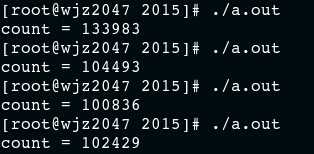标签:
谈到多线程编程,同步是一定要讲的。给个例子:

#include <stdio.h> #include <stdlib.h> #include <pthread.h> int count = 0; #define N 100000 void* fun() { int i; for (i = 0; i < N; ++i) { int tmp = count; tmp++; count = tmp; } } int main() { pthread_t tid1, tid2; int ret1, ret2; ret1 = pthread_create(&tid1, NULL, fun, NULL); ret2 = pthread_create(&tid2, NULL, fun, NULL); pthread_join(tid1, NULL); pthread_join(tid2, NULL); printf("count = %d\n", count); return 0; }
两个线程同时对一个数据执行自增操作,结果是多少呢?

可以看出,每次执行的结果都是不一样的。而且,都不是我们所希望的200000。主要原因是程序里的自增操作不是原子操作,两个线程由于CPU的调度,会交错执行。
接下来,我们通过互斥量来实现两个线程的同步。

#include <stdio.h> #include <stdlib.h> #include <pthread.h> int count = 0; #define N 100000 pthread_mutex_t mutex; void* fun() { int i; for (i = 0; i < N; ++i) { pthread_mutex_lock(&mutex); int tmp = count; tmp++; count = tmp; pthread_mutex_unlock(&mutex); } } int main() { pthread_mutex_init(&mutex, NULL); pthread_t tid1, tid2; int ret1, ret2; ret1 = pthread_create(&tid1, NULL, fun, NULL); ret2 = pthread_create(&tid2, NULL, fun, NULL); pthread_join(tid1, NULL); pthread_join(tid2, NULL); printf("count = %d\n", count); pthread_mutex_destroy(&mutex); return 0; }
在自增操作前后,通过成对的加锁解锁操作,使得自增操作成为一个原子操作,从而达到线程同步。
标签:
原文地址:http://www.cnblogs.com/gattaca/p/4729920.html